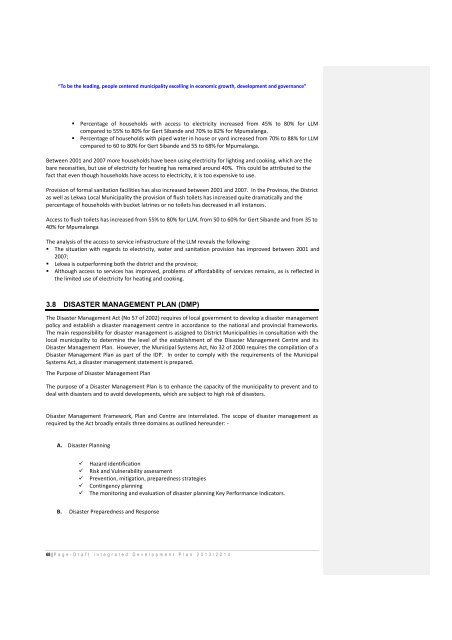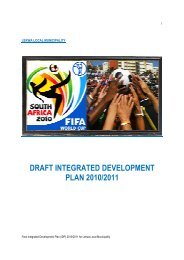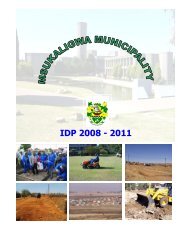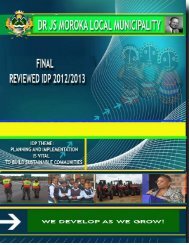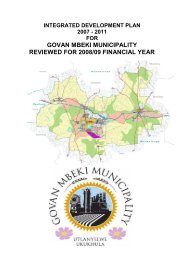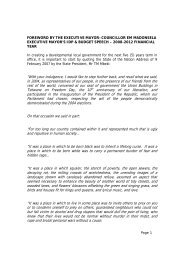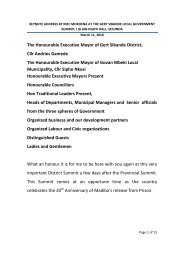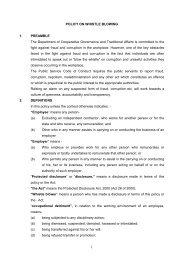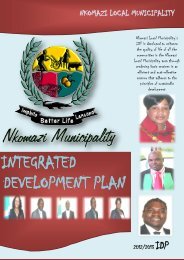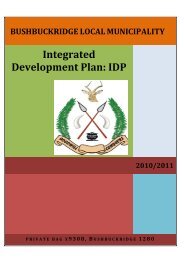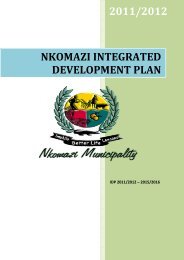Lekwa Local Municipality 2013/14 - Co-operative Governance and ...
Lekwa Local Municipality 2013/14 - Co-operative Governance and ...
Lekwa Local Municipality 2013/14 - Co-operative Governance and ...
Create successful ePaper yourself
Turn your PDF publications into a flip-book with our unique Google optimized e-Paper software.
“To be the leading, people centered municipality excelling in economic growth, development <strong>and</strong> governance”• Percentage of households with access to electricity increased from 45% to 80% for LLMcompared to 55% to 80% for Gert Sib<strong>and</strong>e <strong>and</strong> 70% to 82% for Mpumalanga.• Percentage of households with piped water in house or yard increased from 70% to 88% for LLMcompared to 60 to 80% for Gert Sib<strong>and</strong>e <strong>and</strong> 55 to 68% for Mpumalanga.Between 2001 <strong>and</strong> 2007 more households have been using electricity for lighting <strong>and</strong> cooking, which are thebare necessities, but use of electricity for heating has remained around 40%. This could be attributed to thefact that even though households have access to electricity, it is too expensive to use.Provision of formal sanitation facilities has also increased between 2001 <strong>and</strong> 2007. In the Province, the Districtas well as <strong>Lekwa</strong> <strong>Local</strong> <strong>Municipality</strong> the provision of flush toilets has increased quite dramatically <strong>and</strong> thepercentage of households with bucket latrines or no toilets has decreased in all instances.Access to flush toilets has increased from 55% to 80% for LLM, from 50 to 60% for Gert Sib<strong>and</strong>e <strong>and</strong> from 35 to40% for MpumalangaThe analysis of the access to service infrastructure of the LLM reveals the following:• The situation with regards to electricity, water <strong>and</strong> sanitation provision has improved between 2001 <strong>and</strong>2007;• <strong>Lekwa</strong> is outperforming both the district <strong>and</strong> the province;• Although access to services has improved, problems of affordability of services remains, as is reflected inthe limited use of electricity for heating <strong>and</strong> cooking.3.8 DISASTER MANAGEMENT PLAN (DMP)The Disaster Management Act (No 57 of 2002) requires of local government to develop a disaster managementpolicy <strong>and</strong> establish a disaster management centre in accordance to the national <strong>and</strong> provincial frameworks.The main responsibility for disaster management is assigned to District Municipalities in consultation with thelocal municipality to determine the level of the establishment of the Disaster Management Centre <strong>and</strong> itsDisaster Management Plan. However, the Municipal Systems Act, No 32 of 2000 requires the compilation of aDisaster Management Plan as part of the IDP. In order to comply with the requirements of the MunicipalSystems Act, a disaster management statement is prepared.The Purpose of Disaster Management PlanThe purpose of a Disaster Management Plan is to enhance the capacity of the municipality to prevent <strong>and</strong> todeal with disasters <strong>and</strong> to avoid developments, which are subject to high risk of disasters.Disaster Management Framework, Plan <strong>and</strong> Centre are interrelated. The scope of disaster management asrequired by the Act broadly entails three domains as outlined hereunder: -A. Disaster Planning Hazard identification Risk <strong>and</strong> Vulnerability assessment Prevention, mitigation, preparedness strategies <strong>Co</strong>ntingency planning The monitoring <strong>and</strong> evaluation of disaster planning Key Performance Indicators.B. Disaster Preparedness <strong>and</strong> Response68 | P a g e - D r a f t i n t e g r a t e d D e v e l o p m e n t P l a n 2 0 1 3 / 2 0 1 4


